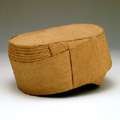The original form of the class system of the Ryukyu Kingdom was created in the reign of King Sho Shin at the end of the 15th century over into the 16th century. In the 17th century the people were divided into three classes, the Daimyo, Samurai, and farmers. Distinctions between Samurai and farmer were made very clear by compilation of the Kafu; a genealogical table worked out by Choshu Haneji starting around 1670. Samurai were ordered to make genealogical tables and were then classified as "Kei mochi" which means those having a genealogy. Farmers, having no genealogy table were classified as "Mukei" meaning those who were without. Social status was clarified by the existence of genealogical table. Descendants of the samurai rank were divided into two classes called Daimyo and Samurai. The princes, Aji chieftains, and Ekata belonged to the Daimyo category. Those of the Daimyo rank were the highest rulers and they were given an area of jurisdiction called a "Magiri" corresponding to a modern city or village. Large residences where princes and Aji chieftains lived were called Udun and residences for Ekata class were called Dunchi. Samurai who came from major Daimyo families were called Satunushi-sujime and were engaged in important posts befitting higher-class samurai descendants. The remaining samurai were called Chikudun-sujime and engaged in general administrative work as a lower class samurai. Chikudun-sujime included farmers who became samurai by meritorious deeds or contributions even though they did not originally have a genealogical table. On the other hand, farmers were divided into town farmers who lived around the Naha and Shuri area and engaged in commerce and industry and the countryside farmers who lived in the country and dealt strictly in agriculture.

Hachimachi
(Crown or hat used to indicate rank)